Mechanisms of action and resistance abstract more than 40 antimicrobial peptides and proteins amps are expressed in the oral cavity. Antimicrobial peptides of multicellular organisms regulation.

Classes Of Antimicrobial Peptides Based On Structure Download Table

Figure 2 From Antimicrobial Peptides Of Multicellular Organisms

Peptide Antimicrobial Agents Clinical Microbiology Reviews
Bacitracin for pneumonia topical.

Antimicrobial peptides. Daptomycin bacterial infections iv. Antimicrobial peptides amps are oligopeptides with a varying number from five to over a hundred of amino acids. These amps have been organized into 6 functional groups 1 of which cationic amps has received extensive attention in recent years for their promise as potential antibiotics.
These proteins can have broad activity to directly kill bacteria yeasts fungi viruses and even cancer cells. Antimicrobial peptides and proteins amps are a diverse class of naturally occurring molecules that are produced as a first line of defense by all multicellular organisms. Antimicrobial peptides amps have attracted extensive research attention worldwide.
Title antimicrobial peptides. 4 are proven to kill bacteria in animal. Antimicrobial peptides are expressed by the epithelial cells within.
Amps have a broad spectrum of targeted organisms ranging from viruses to parasites. Since their discovery in the 1980s antimicrobial host defense peptides amps have been found to be pivotal to host defense against infection representing a fundamentally important component of the immune system widely conserved across plants and animals. 2 do not select for resistant mutants and have limited natural bacterial resistance.
Boceprevir hepatitis c oral cyclic peptide. After the discovery of inducible antimicrobial peptides in silk moths 1. Dalbavancin bacterial infections iv.
Antimicrobial peptides 1 are active against antibiotic resistant isolates. The growing problem of resistance to. Enfuvirtide hiv subcutaneous injection.
Roles in health and disease. This new edition lays the foundations for studying amps including a discovery timeline terminology nomenclature and classifications. 3 are synergistic with conventional antibiotics specifically against resistant mutants.
Harnessing and creating amps synthetically has the potential to help overcome increasing antibiotic resistance in many pathogens. As of january 2018 the following antimicrobial peptides were in clinical use.

Frontiers Antimicrobial Peptides And Nanotechnology Recent
Molecular Farming Of Antimicrobial Peptides Available Platforms And

Antimicrobial Peptides Amps Ancient Compounds That Represent

EmoticonEmoticon